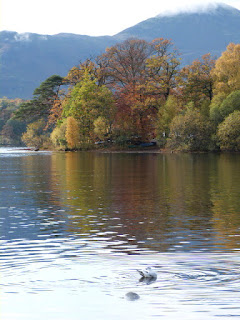A bit of background first...The Peak District was once home to an abundance of sphagnum moss and over many years ancient peatlands formed. However during the industrial revolution, the production of acid rain caused the land to become just too acidic for even these acid loving mosses and degradation of the land was the result. Peat bogs all over the country have also suffered due to harvesting of the peat and drainage of land, erosion by the weather, grazing and competition from non-native plants.
 |
| Sphagnum capillifolium |
In the UK there are 34 different species of sphagnum moss and they come in a variety of leaf shapes and the colours are pretty amazing too - ranging from bright red to bright green. In the Peak District there have been about 15 of these species recorded. In my local area, the Lake District we are lucky enough to have quite an abundance of sphagnum moss.
 |
| Sphagnum moss |
 |
| Polytrichum commune pictured on the right here - often confused with sphagnum moss |
Sphagnum moss plays a major part in the fomation of peat, which takes many years to form. In waterlogged conditions, decomposition of plant material is extremely slow or non existent. Waterlogged areas become anoxic - that is lacking in oxygen and so the decomposing bacteria cannot survive. Sphagnum moss grows from the top and does not possess roots and as the bottom of the plant dies - it goes through this slow decomposition process until it eventually forms peat along with other organic plant material.
Why is Peat so Important?
Peat could be described as a carbon store and a historical record of environmental conditions over the years. The organic material that forms peat is made of carbon and this carbon is essentially gets locked up in the peat store.
Climate Change and Sphagnum Moss
With ever increasing temperatures sphagnum moss could become more threatened. Sphagnum moss can hold about 20 times its own weight in water and over 15 degrees C it begins to degrade.
Why Survey Sphagnum Moss?
The Moors for the Future Project have been been working hard to restore the sphagnum moss to the blanket bog peatlands of the Peak District to try and protect the peat. They now want the general public to help to see if this has been successful. More information on how to do this can be found on the Moors for Future Project website
The basics of the survey is to find a path by using the website and a starting point to survey from. Record your start point and off you go. You need to survey up to 2 metres either side of the path. You measure the size of a patch found in 25 cm segments and write down the grid reference of where you found it.
You need to specify the growth form : Hummock, carpet or wet hollow and then specify the habitat it is found in:
Bog, heath, grassland, flush or woodland.
A photograph of the patch is handy to show the area it is found in and then a close up to help with species identification.
How do you identify Sphagnum Moss?
Sphagnum moss is often confused with Polytrichum moss (pictured above), which is another common type of moss found in both the lowlands and the uplands.
One distinguishing feature that is very useful in identifying sphagnum moss is that it has a capitulum at the top of the central stem. Identifying the individual species gets a little more complicated! There are some good identification guides out there but its best to use a hand lens and a good guide to ensure you get your identifaction correct. For the big moss map survey - the main thing is finding the clumps of sphagnum and then trying to identify the individual species.
 |
| Sphagnum moss |
 |
| Feather moss - has no capitullum like Sphagnum moss |
 |
| Common feather moss - no capitulum |
Some of the most common sphagnum moss species include Sphagnum capillifolium, Sphagnum fallax, Sphagnum denticulatum, Sphagnum papillosum and Sphagnum pallustre. And some of the best guides to identify these with are the Field Studies Council Guide or have a look at the British Bryological Society website and there are also some good books around.
Here's a couple of my favourite books and guides:
The great thing about sphagnum moss or in fact any species of moss is that it doesn't fly or run away and it is present pretty much all year round. This makes it a perfect species to go our and have some fun looking for and trying to identify...but beware it could become quite addictive! if you are interested in helping out just go to the Moor for the Future website, download some survey forms and get out there!



















